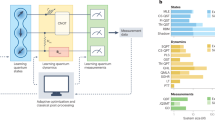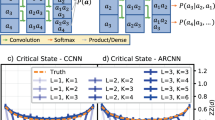Abstract
The experimental realization of increasingly complex synthetic quantum systems calls for the development of general theoretical methods to validate and fully exploit quantum resources. Quantum state tomography (QST) aims to reconstruct the full quantum state from simple measurements, and therefore provides a key tool to obtain reliable analytics1,2,3. However, exact brute-force approaches to QST place a high demand on computational resources, making them unfeasible for anything except small systems4,5. Here we show how machine learning techniques can be used to perform QST of highly entangled states with more than a hundred qubits, to a high degree of accuracy. We demonstrate that machine learning allows one to reconstruct traditionally challenging many-body quantities—such as the entanglement entropy—from simple, experimentally accessible measurements. This approach can benefit existing and future generations of devices ranging from quantum computers to ultracold-atom quantum simulators6,7,8.
This is a preview of subscription content, access via your institution
Access options
Access Nature and 54 other Nature Portfolio journals
Get Nature+, our best-value online-access subscription
$29.99 / 30 days
cancel any time
Subscribe to this journal
Receive 12 print issues and online access
$209.00 per year
only $17.42 per issue
Buy this article
- Purchase on Springer Link
- Instant access to full article PDF
Prices may be subject to local taxes which are calculated during checkout



Similar content being viewed by others
References
Vogel, K. & Risken, H. Determination of quasiprobability distributions in terms of probability distributions for the rotated quadrature phase. Phys. Rev. A. 40, 2847 (1989).
Leonhardt, U. Quantum-state tomography and discrete Wigner function. Phys. Rev. Lett. 74, 4101–4105 (1995).
White, A. G., James, D. F. V., Eberhard, P. H. & Kwiat, P. G. Nonmaximally entangled states: production, characterization, and utilization. Phys. Rev. Lett. 83, 3103–3107 (1999).
Häffner, H. et al. Scalable multiparticle entanglement of trapped ions. Nature 438, 643–646 (2005).
Lu, C.-Y. et al. Experimental entanglement of six photons in graph states. Nat. Phys. 3, 91–95 (2007).
Bloch, I., Dalibard, J. & Zwerger, W. Many-body physics with ultracold gases. Rev. Mod. Phys. 80, 885–964 (2008).
Blatt, R. & Roos, C. F. Quantum simulations with trapped ions. Nat. Phys. 8, 277–284 (2012).
Shulman, M. D. et al. Demonstration of entanglement of electrostatically coupled singlet-triplet qubits. Science 336, 202–205 (2012).
Hinton, G. E. & Salakhutdinov, R. R. Reducing the dimensionality of data with neural networks. Science 313, 504–507 (2006).
LeCun, Y., Bengio, Y. & Hinton, G. Deep learning. Nature 521, 436–444 (2015).
Wang, L. Discovering phase transitions with unsupervised learning. Phys. Rev. B 94, 195105 (2016).
Carrasquilla, J. & Melko, R. G. Machine learning phases of matter. Nat. Phys. 13, 431–434 (2017).
van Nieuwenburg, E. P. L., Liu, Y.-H. & Huber, S. D. Learning phase transitions by confusion. Nat. Phys. 13, 435–439 (2017).
Carleo, G. & Troyer, M. Solving the quantum many-body problem with artificial neural networks. Science 355, 602–606 (2017).
Gross, D., Liu, Y.-K., Flammia, S. T., Becker, S. & Eisert, J. Quantum state tomography via compressed sensing. Phys. Rev. Lett. 105, 150401 (2010).
Tóth, G. et al. Permutationally invariant quantum tomography. Phys. Rev. Lett. 105, 250403 (2010).
Cramer, M. et al. Efficient quantum state tomography. Nat. Commun. 1, 149 (2009).
Lanyon, B. P. et al. Efficient tomography of a quantum many-body system. Nat. Phys. 13, 1158–1162 (2017).
Deng, D.-L., Li, X. & Sarma, S. D. Machine learning topological states. Phys. Rev. B 96, 195145 (2017).
Torlai, G. & Melko, R. G. Neural decoder for topological codes. Phys. Rev. Lett. 119, 030501 (2017).
Deng, D.-L., Li, X. & Das Sarma, S. Quantum entanglement in neural network states. Phys. Rev. X 7, 021021 (2017).
Gao, X. & Duan, L.-M. Efficient representation of quantum many-body states with deep neural networks. Nat. Commun. 8, 662 (2017).
Chen, J., Cheng, S., Xie, H., Wang, L. & Xiang, T. On the equivalence of restricted Boltzmann machines and tensor network states. Preprint at http://arxiv.org/abs/1701.04831 (2017).
Huang, Y. & Moore, J. E. Neural network representation of tensor network and chiral states. Preprint at http://arxiv.org/abs/1701.06246 (2017)
Torlai, G. & Melko, R. G. Learning thermodynamics with Boltzmann machines. Phys. Rev. B 94, 165134 (2016).
Wang, X.-L. et al. Experimental ten-photon entanglement. Phys. Rev. Lett. 117, 210502 (2016).
Richerme, P. et al. Non-local propagation of correlations in quantum systems with long-range interactions. Nature 511, 198–201 (2014).
Islam, R. et al. Measuring entanglement entropy in a quantum many-body system. Nature 528, 77–83 (2015).
Hastings, M. B., González, I., Kallin, A. B. & Melko, R. G. Measuring Renyi entanglement entropy in quantum Monte Carlo simulations. Phys. Rev. Lett. 104, 157201 (2010).
Bakr, W. S. et al. Probing the superfluid-to-Mott insulator transition at the single-atom level. Science 329, 547–550 (2010).
Johnson, M. W. et al. Quantum annealing with manufactured spins. Nature 473, 194–198 (2011).
Hinton, G. E. Training products of experts by minimizing contrastive divergence. Neural Comput. 14, 1771–1800 (2002).
Goodfellow, I., Bengio, Y. & Courville, A. Deep Learning (MIT Press, Cambridge, MA, 2016).
Amari, S.-i Natural gradient works efficiently in learning. Neural Comput. 10, 251–276 (1998).
Sorella, S. Green function Monte Carlo with stochastic reconfiguration. Phys. Rev. Lett. 80, 4558 (1998).
Becca, F. & Sorella, S. Quantum Monte Carlo Approaches for Correlated Systems (Cambridge Univ. Press, Cambridge, 2017).
Acknowledgements
We thank L. Aolita, H. Carteret, G. Tóth and B. Kulchytskyy for useful discussions. G.T. thanks the Institute for Theoretical Physics, ETH Zurich, for hospitality during various stages of this work. G.T. and R.M. acknowledge support from NSERC, the Canada Research Chair programme, the Ontario Trillium Foundation and the Perimeter Institute for Theoretical Physics. Research at the Perimeter Institute is supported through Industry Canada and by the Province of Ontario through the Ministry of Research and Innovation. G.C., G.M. and M.T. acknowledge support from the European Research Council through ERC Advanced Grant SIMCOFE, and the Swiss National Science Foundation through NCCR QSIT and MARVEL. Simulations were performed on resources provided by SHARCNET, and by the Swiss National Supercomputing Centre CSCS.
Author information
Authors and Affiliations
Contributions
G.C. designed the research. G.T. devised the machine learning methods. G.T., G.M. and J.C. performed the machine learning numerical experiments. G.M. performed QMC simulations. All authors contributed to the analysis of the results and writing of the manuscript.
Corresponding author
Ethics declarations
Competing interests
The authors declare no competing financial interests.
Additional information
Publisher’s note: Springer Nature remains neutral with regard to jurisdictional claims in published maps and institutional affiliations.
Supplementary information
Supplementary Information
Supplementary Figures 1–5, Supplementary Notes, Supplementary References.
Rights and permissions
About this article
Cite this article
Torlai, G., Mazzola, G., Carrasquilla, J. et al. Neural-network quantum state tomography. Nature Phys 14, 447–450 (2018). https://doi.org/10.1038/s41567-018-0048-5
Received:
Accepted:
Published:
Issue Date:
DOI: https://doi.org/10.1038/s41567-018-0048-5
This article is cited by
-
Variational Monte Carlo with large patched transformers
Communications Physics (2024)
-
Improved machine learning algorithm for predicting ground state properties
Nature Communications (2024)
-
Language models for quantum simulation
Nature Computational Science (2024)
-
Coincidence imaging for Jones matrix with a deep-learning approach
npj Nanophotonics (2024)
-
Gaussian-discrete restricted Boltzmann machine with sparse-regularized hidden layer
Behaviormetrika (2024)



